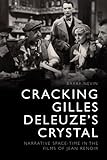Cracking Gilles Deleuze’s Crystal : Narrative Space-time in the Films of Jean Renoir / Barry Nevin.
Material type: TextPublisher: Edinburgh : Edinburgh University Press, [2022]Copyright date: ©2018Description: 1 online resource (256 p.) : 20 B/W illustrationsContent type:
TextPublisher: Edinburgh : Edinburgh University Press, [2022]Copyright date: ©2018Description: 1 online resource (256 p.) : 20 B/W illustrationsContent type: - 9781474426299
- 9781474426305
- 791.430233092 (R)
- PN1998.3.R46 N48 2018
- PN1998.3.R46 N48 2018
- online - DeGruyter
| Item type | Current library | Call number | URL | Status | Notes | Barcode | |
|---|---|---|---|---|---|---|---|
 eBook
eBook
|
Biblioteca "Angelicum" Pont. Univ. S.Tommaso d'Aquino Nuvola online | online - DeGruyter (Browse shelf(Opens below)) | Online access | Not for loan (Accesso limitato) | Accesso per gli utenti autorizzati / Access for authorized users | (dgr)9781474426305 |
Frontmatter -- Contents -- Figures -- Notes on Style -- Acknowledgements -- Preface -- Introduction -- CHAPTER 1 Theatrum Mundi: Framing Urban Dynamics in Renoir’s Paris -- CHAPTER 2 From Desert to Dreamscape: Viewing Renoir’s Rural Landscapes as Spatial Arenas -- CHAPTER 3 Portraying the Future(s) of the Front Populaire -- CHAPTER 4 Renoir’s crises anti-réalistes: Framing le temps gelé -- Conclusion -- Appendix: Corpus Breakdown -- Notes -- References -- Film Index -- General Subject Index
restricted access online access with authorization star
http://purl.org/coar/access_right/c_16ec
Applies complex Deleuzian thought to the quintessential French auteurJean Renoir is widely considered as one of the most important technical innovators and politically engaged filmmakers in cinema history. Reassessing the unique qualities of Renoir’s influential visual style by interpreting his films through Gilles Deleuze’s film philosophy, and through previously unpublished production files, Barry Nevin provides a fresh and accessible interdisciplinary perspective that illuminates both the consistency and diversity of Renoir’s oeuvre. Exploring canonised landmarks in Renoir’s career, including La Grande Illusion (1937) and La Règle du jeu (1939), the book also considers neglected films such as Le Bled (1929) and Diary of a Chambermaid (1946) to present a rounded analysis of this quintessential French auteur’s oeuvre.Key FeaturesExamines the complex relationship between Deleuze’s film philosophy and spatial thought with clarityClearly theorises key concepts including time and spaceAnalyses films from each phase of Renoir’s career including his silent work, his politically engaged features of the 1930s, his Hollywood films and his post-war costume-dramasInvestigates Renoir’s key settings, political engagement and evolutions in his narrative style
Mode of access: Internet via World Wide Web.
In English.
Description based on online resource; title from PDF title page (publisher's Web site, viewed 29. Jun 2022)


